By the staff of Giorgio Nada Editore
When the Mille Miglia emerged from the ashes of the Second World War in the June of 1947, among the crowds thronging Brescia’s Piazza della Vittoria in those early summer days was a young man with a camera slung around his neck, absorbed in capturing faces, cars and views with his Leica.
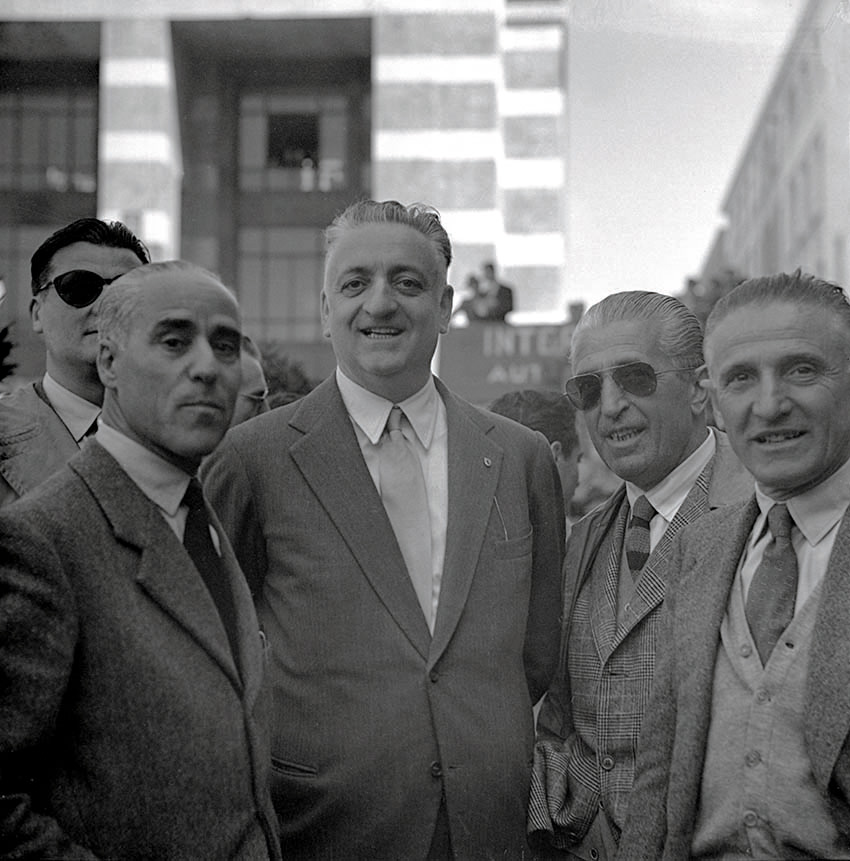
Almost forgotten by both Ferrari and Alfa Romeo, in 1948 Tazio Nuvolori, left, was recuperating at Lake Garda from his lung disease. But at the last minute both Alfa and Ferrari (center) asked Nuvolari if he would like a drive for the race. He took up on Ferrari’s offer, and with a cycle-fendered 166 Ferrari, led most of the event only to retire at Reggio Emilia.
Alberto Sorlini, class of 1920, moved confidently among those cars, some of them more sporting than others, and among the established stars and the promising youngsters, to the extent that once the curtain had come down on the 14th edition of the Brescian classic, his shots were noticed by the ever vigilant Renzo Castagneto, deus ex machine of the Mille Miglia, who from 1948 engaged Sorlini as the race’s official photographer on a formal contract.
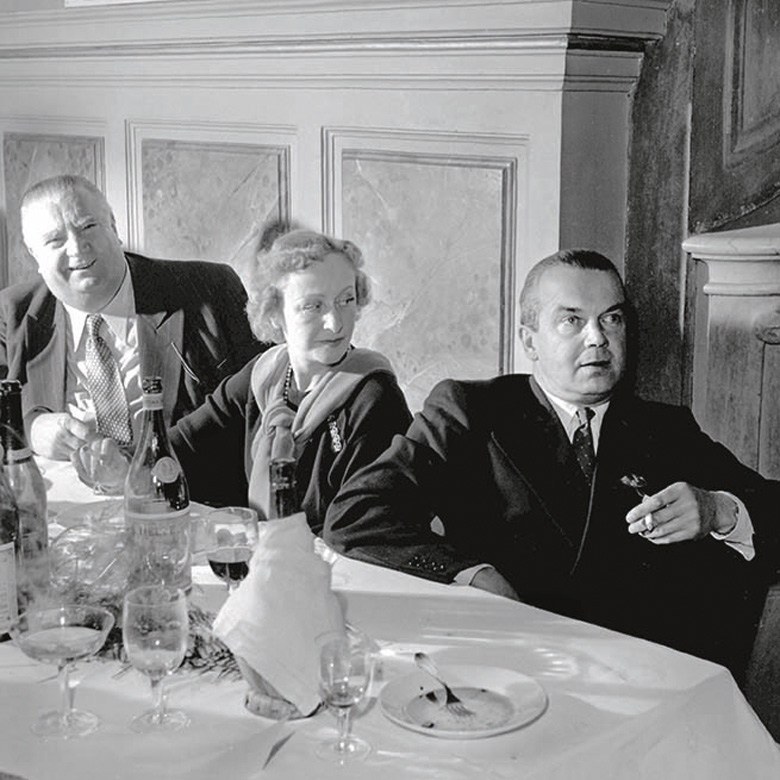
Sorlini’s job also included photographing the famous team members and drivers at ceremonies. In 1952 the Mercedes-Benz returned to the Mille Miglia with both Neubauer (left), and Rudolph Caracciola. Though Caracciola had been the only non-Italian to win the event in 1931, he only managed to finish fourth in the 1952 race.
The tasks entrusted to the young talent were straightforward: he was to document the always fascinating pre-race scrutineering sessions in Piazza della Vittoria in Brescia, gleaning secrets and snapping faces; he was then to move to the start line area where, for an entire night he was to photograph the fateful moment of the departure of virtually every competitor, from those entered in the minor classes through to those driving the works sports cars in the blue ribbon categories and destined to be competing for overall victory.
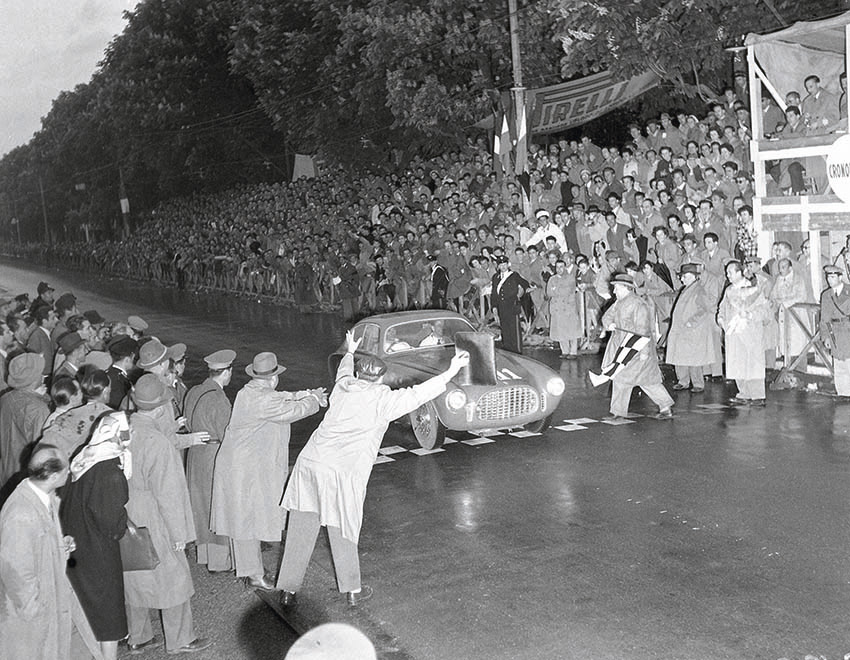
Bracco’s Ferrari comes across the finish line in 1952, some five minutes ahead of the Kling/Klenk Mercedes 300SL after a drive of heroic and historic proportions. “Giovanni Bracco won a Mille Miglia that seemed lost to Ferrari,” said Count Giovanni Lurani. Sorlini was there to capture the moment.
Moreover, Sorlini was also tasked with documenting the competitors’ return to Brescia, with the help of a few young assistants placed at strategic spots around the city while he stationed himself at the finish waiting for the protagonists to cross the line after what was always a gruelling race.

1954 was another wet Mille Miglia, and a duel between the new 3.3 liter Lancia and the Ferrari team was expected to be dramatic. It was, and when the leading Lancia of Piero Taruffi retired at Vetralla, Alberto Ascari took his Lancia to his first and last win at the 1000 mile race.
In conclusion, ahead of the next edition of the race, Sorlini would be asked to photograph the prize giving ceremony that would always be held in the sumptuous setting of Brescia’s Teatro Grande, an occasion that would see a gathering of the greats of Fifties motorsport.
Between 1947 and 1957, the year in which the terrible accident involving the Ferrari of De Portago and Nelson cost the lives of the drivers and nine spectators put an end to the one and only Mille Miglia, Sorlini became a faithful chronicler of the great Brescian race, assembling a photographic archive of almost 9,000 shots, mostly in black and white, but with a few precious rolls of colour film. This archive today represents historical and cultural testimony of the utmost importance, firstly for the Mille Miglia but also for motorsport in general. All the greatest drivers of the Fifties passed in front of Sorlini’s lens, from Nuvolari to Fangio, from the Marzotto brothers to Ascari, from Moss to Castellotti and Taruffi to mention but a few, accompanied naturally by the most prestigious cars of the era: from the small, sports cars of the minor classes – those that Sorlini loved to describe as “death traps”, to the Touring and GT models that were authentic sporting icons of the period, through to the unforgettable sports cars that each year would be duelling for overall victory.
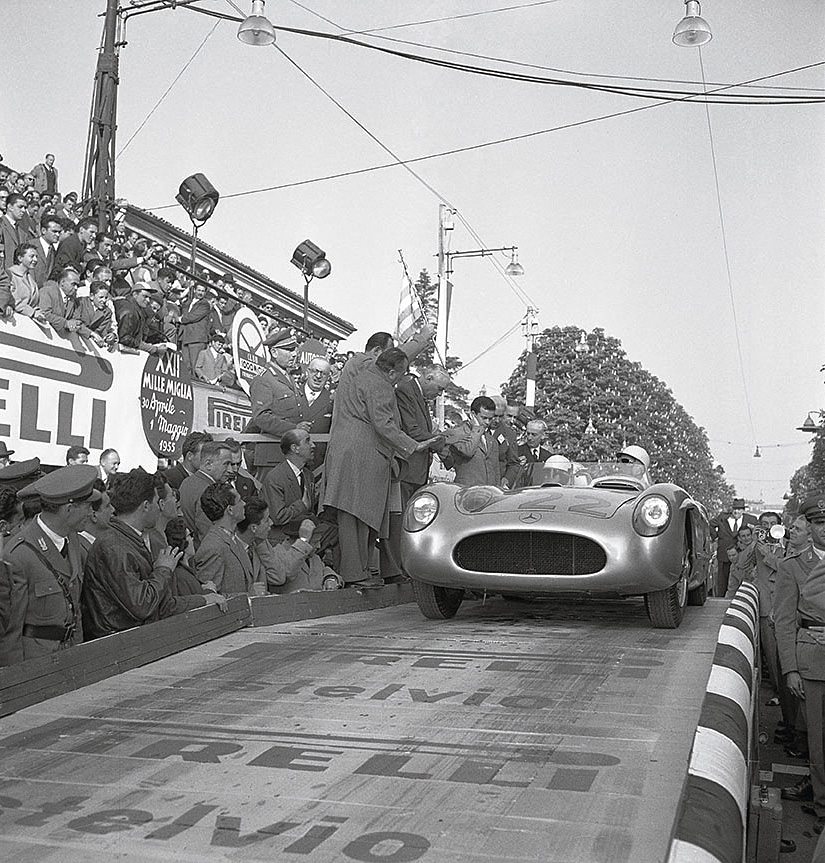
The beginning of the epochal 1955 journey of Stirling Moss and Denis Jenkinson that would take them 1000 miles at a record average speed of 98.5 mph to win in 10 hours, seven minutes and 48 seconds. It would be the fastest Mille Miglia ever and the record was never broken.
In those 11 years of passionate commitment, Sorlini documented the Italian cars and drivers, but also all the foreign entrants: from the works Healeys entered in 1948 for Count Giovannino Lurani and Donald Healey himself to the Frazer-Nashes that aroused the interest of the public in 1949; from the powerful Mercedes expedition in search of overall victory in 1952 to the works Aston Martins and Jaguars that rolled up for the start in 1953 when the Mille Miglia was part of the new World Championship for Makes and through to Moss and Jenkinson’s memorable victory in the 1955 edition.
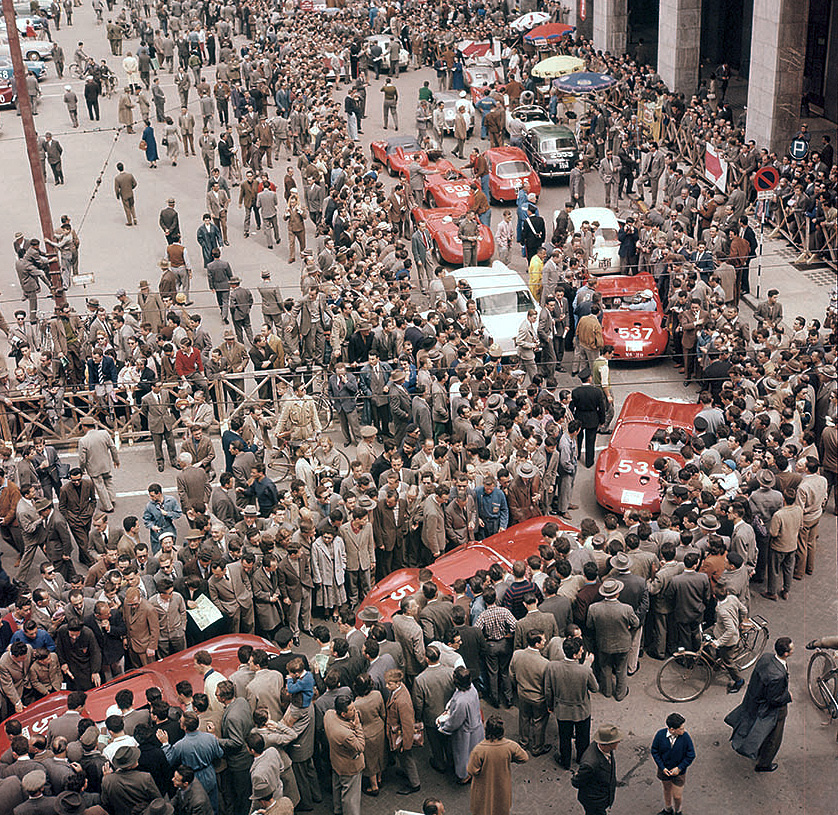
The might of the Maserati team lines up for scrutineering before the fatal, final Mille Miglia in 1957, captured in color by Sorlini. There would be but a single Maserati in the top ten finishers, that of Scarlatti, who finished fourth.
When the final curtain came down on the Mille Miglia in 1957, Alberto Sorlini, who it should be remembered was also the official photographer for the Circuito del Garda, was by no means ready to call time on his career, quite the contrary. He devoted himself in particular to industrial photography, working for many firms in the Brescia area, producing fascinating reportages for Epoca and sporadically working in the field of fashion. Crowning his long and prolific career, he founded the Museo della Fotografia in Brescia, within the ambit of which he continued to work tirelessly for many more years before his death at the age of 96, in the October of 2016.
The Novafoto-Sorlini archive today
In 1989, the entire corpus of photographs dedicated to the Mille Miglia became the property of Giorgio Nada Editore and shortly afterwards, given its particular historical-cultural value, was placed under the protection of the Superintendency of Archival Heritage of the Lombardy Region. In the meantime, the publisher has proceeded to caption the almost 9,000 images and completed the long and laborious process of digitalizing them.
For some time now, the archive has been available to historians, researchers, collectors and mere enthusiasts who may acquire individual shots for private use and for publication.
The next step, which is already underway, will be the definitive release of the archive online, providing all enthusiasts of motorsport history with a quite remarkable historical and sporting resource.
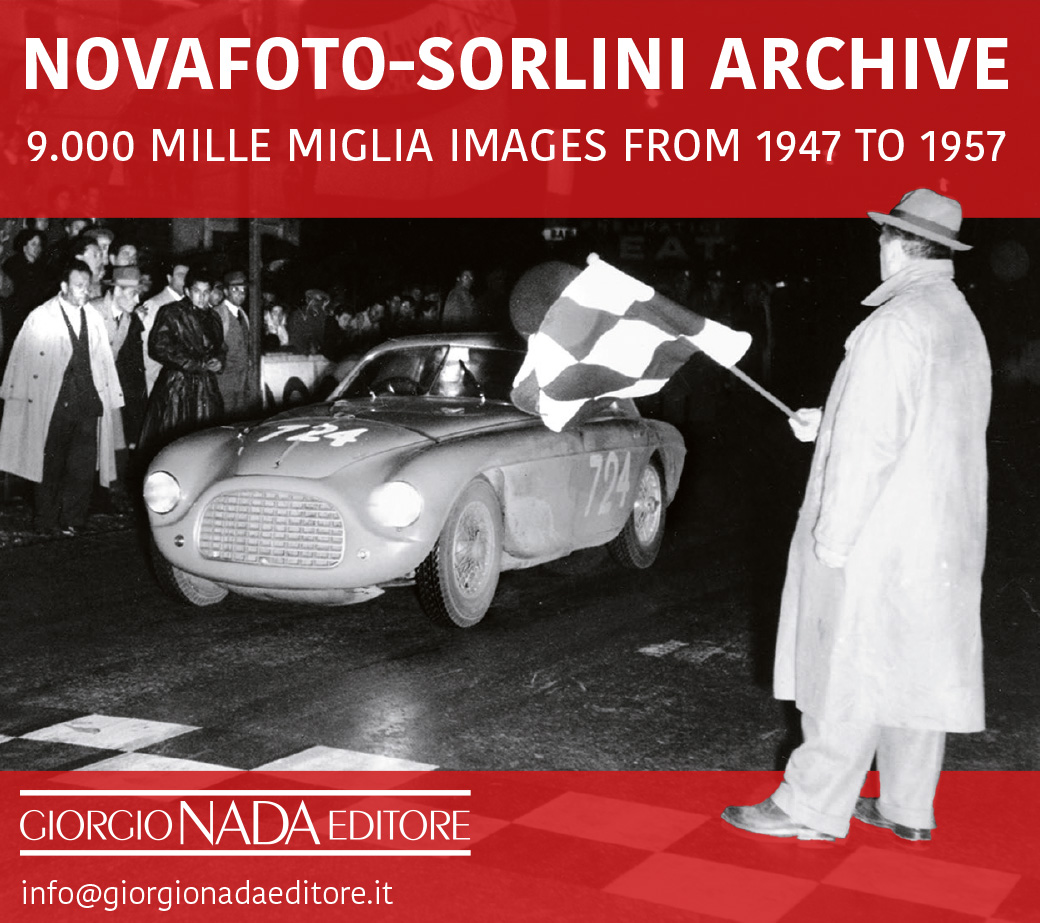
A fascinating report on an historically important subject. As somebody whose lifelong interest in classic motorsport began with vivid press reports and fleeting newsreels of the Mille Miglia in the fifties, the release online of these historic photographs can’t come soon enough.
somewhere, SOMEWHERE, I have 50′ of 16mm color film I took from a ditch on the outside of a medium-fast righthand bend, about 10 miles before portago’s crash. I remember checking his car number against the movie film to be sure. it’s with several other reels. but WHERE?
Wonderful pictures showing both the Mille Miglia as well as everyday 40s and 50s Italy. On top of racing testimony, they are equally significant for sociological reasons… Thumbs up to Girogio Nada for making sure this treasure is secured for the future générations. Cant’ wait to discover them all, after the books already published by Giorgio Nada Editore.
I was lucky enough to be able to be able to buy a number of Alfa Romeo 1900 photos direct from Alberto Sorlini a few years before his archives came up for sale at auction in Italy. Fortunately they remained intact and the archives was bought by Giorgio Nada. I WISH that I had bought more prints for Sorlino direct. Nada will sell them, (100 €uros each) but copyright remains his. Peter